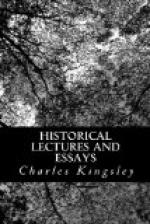Zarathustra, the mystery of evil, weighed heavily on them and on their great prophet, Zoroaster—splendour of gold, as I am told his name signifies—who lived, no man knows clearly when or clearly where, but who lived and lives for ever, for his works follow him. He, too, tried to solve for his people the mystery of evil; and if he did not succeed, who has succeeded yet? Warring against Ormuzd, Ahura Mazda, was Ahriman, Angra Mainyus, literally the being of an evil mind, the ill-conditioned being. He was labouring perpetually to spoil the good work of Ormuzd alike in nature and in man. He was the cause of the fall of man, the tempter, the author of misery and death; he was eternal and uncreate as Ormuzd was. But that, perhaps, was a corruption of the purer and older Zoroastrian creed. With it, if Ahriman were eternal in the past, he would not be eternal in the future. Somehow, somewhen, somewhere, in the day when three prophets—the increasing light, the increasing truth, and the existing truth—should arise and give to mankind the last three books of the Zend-avesta, and convert all mankind to the pure creed, then evil should be conquered, the creation become pure again, and Ahriman vanish for ever; and, meanwhile, every good man was to fight valiantly for Ormuzd, his true lord, against Ahriman and all his works.
Men who held such a creed, and could speak truth and draw the bow, what might they not do when the hour and the man arrived? They were not a big nation. No; but they were a great nation, even while they were eating barley-bread and paying tribute to their conquerors the Medes, in the sterile valleys of Farsistan.
And at last the hour and the man came. The story is half legendary—differently told by different authors. Herodotus has one tale, Xenophon another. The first, at least, had ample means of information. Astyages is the old shah of the Median Empire, then at the height of its seeming might and splendour and effeminacy. He has married his daughter, the Princess Mandane, to Cambyses, seemingly a vassal-king or prince of the pure Persian blood. One night the old man is troubled with a dream. He sees a vine spring from his daughter, which overshadows all Asia. He sends for the Magi to interpret; and they tell him that Mandane will have a son who will reign in his stead. Having sons of his own, and fearing for the succession, he sends for Mandane, and, when her child is born, gives it to Harpagus, one of his courtiers, to be slain. The courtier relents, and hands it over to a herdsman, to be exposed on the mountains. The herdsman relents in turn, and bring the babe up as his own child.
When the boy, who goes by the name of Agradates, is grown, he is at play with the other herdboys, and they choose him for a mimic king. Some he makes his guards, some he bids build houses, some carry his messages. The son of a Mede of rank refuses, and Agradates has him seized by his guards and chastised with the whip. The ancestral instincts of command and discipline are showing early in the lad.




